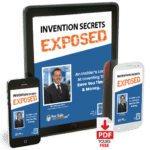Intellectual Property Basics

|
What is Intellectual Property? Intellectual property consists of patents, trademarks, copyrights, trade dress, trade secrets, and the like that constitute valuable and protectable knowledge that a person or business may possess. Although the value is generally in the application of the idea in commerce, the property itself is often identified by a written document (a patent, a license agreement, a trademark, etc.) and the differences described between the improvement and the “prior art”, i.e. what was already known before the development of the intellectual property. |
|
What Is A Patent? A patent is a property right granted by the United States government only to the true inventor, excluding all others from making, using or selling the invention. A patent is granted for a specific term after which it enters public domain and may be freely used by anyone. They allow the holder exclusive right to make, use or sell the invention within the United States. In the United States, since The America Invents Act of 2011, priority and defensive rights go to the first person to actually file a patent for an invention. Patents are granted for any new and useful process, machine, manufacture, or composition of matter. Although, in general, mathematical formulas are considered to be not patentable, recent changes have paved the way for patents protecting business methods and computer programs. Patents are not issued for perpetual motion machines, printed matter or mere “ideas”, but rather on the tangible expression of those ideas. A new use of a known process, machine, manufacture, composition of matter or material may be eligible for patent protection. However, a patent is NOT granted if the invention was sold or publicly known anywhere in the world for more than one year prior to filing for a patent. This is often referred to as the 1-Year Rule. |
|
Is My Idea Patentable? Even if you have a new idea or innovated use that may a meet the above criteria, there are many statutory requirements that must be met before a patent is granted. By statute, 35 U.S.C. §102 states a person shall be entitled to a patent unless:
The patent laws impose the following additional requirements for patentability:
The latter requirement is the most difficult test to meet. The Patent Statute sets forth this requirement as follows: 35 U.S.C. §103. CONDITIONS FOR PATENTABILITY: NON-OBVIOUS SUBJECT MATTER. A patent may not be obtained though the invention is not identically disclosed or described as set forth in section 102 of this title, if the differences between the subject matter sought to be patented and the prior art are such that the subject matter as a whole would have been obvious at the time the invention was made to a person having ordinary skill in the art to which said subject matter pertains. Patentability shall not be negatived by the manner in which the invention was made. The United States Supreme Court has set forth the following test or procedure to be used in applying the above statutory requirement for non-obviousness: The scope and content of the prior art are to be determined; Differences between the prior art and the invention at issue are to be ascertained; A level of ordinary skill in the pertinent art is resolved; Against this background, the obviousness or non-obviousness of the subject matter is determined. In addition to all of this, the Supreme Court has further stated that secondary considerations may also be considered indicia of obviousness or nonobviousness. These can include:
|
|
Are there Different Types of Patents? Yes. The main classifications of patents are as follows: A Provisional Patent is a limited, one-year filing with limited power that can be utilized for certain cases. It is not examined, and will be abandoned after one year unless the inventor takes some steps to convert this to a Utility Patent. It is often used by inventors to raise capital, gauge marketability, and/or to test various embodiments. Although filing a Provisional Patent appears to be easy to the un-informed, special care to maintain priority rights as well as many other important patent considerations need to be strategized. A Utility Patent protects the function of an invention, and is granted for a twenty-year term for new, useful and non-obvious process, machine, article of manufacture, composition of matter, business methods or an eligible improvement thereof. This is the most common type of patent protection. A Design Patent protects the overall appearance, or the ornamental nature of an invention. If used appropriately, it can be of value in protecting the aesthetics of new industrial designs. It is granted for fourteen-year protection for any new, original and visible ornamental design of an invention. A Plant Patent is a twenty-year grant for asexually reproduced varieties of distinct or new plants, hybrids and seedlings other than tuber-propagated or existing in an uncultivated state. Does a Patent Make an Idea Valuable? No. Although many people assume that a patented item will sell itself, it must be kept in mind that a patent is not a grant of a right to sell, or to lend value, to an invention. It is exclusively the right to exclude others from making, using, or selling. It provides ownership of intellectual property. However, there are many ways to financially benefit from a patent, such as through sale, licensing, or assignment of rights. Whether your are an independent inventor or a business, a patent can be a valuable asset when used as a tool to aid in marketing the product, to protect the ownership of an invention, or to help identify the exact nature of any property that is being licensed, assigned, or sold. What is Patent Pending? The words “Patent Pending” are placed on a product by a manufacturer to inform the public (and competition) that an application has been filed covering that product. It is a warning sign, like a “Do Not Trespass” sign to warn potential infringers. It is a felony to deceive the public by stating that a product is “patent pending” when it is not. How Long Does the Patent Process Take? After filing a patent application and becoming “patent pending”, the application is examined by the United States Patent and Trademark Office to insure the requirements for patentability are met. This process can take a little as six (6) months for simple design patents, to between 12 and 24 months for simple and complex mechanical utility patents, to well longer for complex electronic or pharmaceutical products. It is normal for an application to be challenged by the USPTO at least once requiring the inventor, or his representative, to provide an answer, a legal argument, an amendment or similar prosecution. Although the Patent Office has a goal of issuing patents within 18 months, this is merely a goal that is missed as often as it is met. Once a patent is issued, it becomes public knowledge. Is International Patent Protection Available? Patents are generally issued by individual countries or groups of countries for protection within those areas. There does exist, however, the Patent Cooperation Treaty, which lays out an agreed upon mechanism that allows the inventor in the United States to delay filing in individual countries for up to 30 months after the first U.S. Patent is filed. However, the first important deadline occurs exactly one year after filing for a U.S. Patent. Because of the complexity and expense, this option is not chosen as often. It would be advisable to discuss these options with your patent attorney approximately 9 months after filing a U.S. patent. Even without international protection, your U.S. Patent will protect against the importation of an infringing product into the U.S., or the sale of your product made here overseas. What is a Trademark? A trademark is either a word, or groups of words, a phrase, a symbol or design, a logo or combination thereof which identifies the source of goods or services to be rendered. Normally a trademark for goods appears on the product and/or packaging, while a service mark appears in advertising for the service. All registered marks are valid throughout the United States and can last indefinitely as long as the owner continues to renew the mark and use the mark in interstate commerce. Specifically, a trademark is a word, phrase, symbol or design, or a combination of words, phrases, symbols or designs, that identifies and distinguishes the source of the goods of one party from those of others. A service mark is the same as a trademark, except that it identifies and distinguishes the source of a service rather than a product. Throughout this section, the terms “trademark” and “mark” refer to both trademarks and service marks. What is a Copyright? A copyright is a form of ownership and legal protection for “original works of authorship.” The copyrighted work must be in tangible form. The Copyright Act generally gives the owner of the copyright the exclusive right to reproduce, prepare derivative works, distribute copies, publicly perform, or display the work of artistic expression. In cases of “works for hire” the employer and not the employee is considered the owner of the copyright. |
|
Copyrightable works include the following categories:
These categories should be viewed broadly. For example, computer programs and most “compilations” may be registered as “literary works”; maps and architectural plans may be registered as “pictorial, graphic, and sculptural works.” Several categories of material are generally not eligible for federal copyright protection. These include among others: Works that have not been fixed in a tangible form of expression (for example, choreographic works that have not been notated or recorded, or improvisational speeches or performances that have not been written or recorded) Titles, names, short phrases, and slogans; familiar symbols or designs; mere variations of typographic ornamentation, lettering, or coloring; mere listings of ingredients or contents Ideas, procedures, methods, systems, processes, concepts, principles, discoveries, or devices, as distinguished from a description, explanation, or illustration Works consisting entirely of information that is common property and containing no original authorship (for example: standard calendars, height and weight charts, tape measures and rulers, and lists or tables taken from public documents or other common sources) What is a Trade Secret? The modern definition of trade secret encompasses any information that can be used in the operation of a business or other enterprise and that is sufficiently valuable and secret to afford an actual or potential economic advantage over others. The law provides protection for trade secrets if certain legal requirements are met. However, unlike patents, copyrights and trademarks, there is no office or agency where you can file a trade secret application, obtain a review by a qualified examiner, and be issued an official trade secret certificate. The legal protection of trade secrets instead requires self-administration by the trade secret owner. And trade secrets, once lost, are lost forever. |








